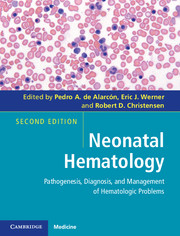Book contents
- Frontmatter
- Contents
- Contributors
- Foreword
- Preface
- 1 A historical review
- Section I Developmental hematology
- Section II Erythrocyte disorders
- 4 Anemia of prematurity and erythropoietin therapy
- 5 Bone marrow failure syndromes
- 6 Hemolytic disease of the fetus and newborn
- 7 Neonatal hemolysis
- 8 Neonatal screening for red blood cell disorders
- 9 Polycythemia and hyperviscosity in the newborn
- Section III Platelet disorders
- Section IV Leukocyte disorders
- Section V Immunologic disorders
- Section VI Hemostatic disorders
- Section VII Transfusional medicine
- Section VIII Miscellaneous
- Index
- Plate section
- References
5 - Bone marrow failure syndromes
from Section II - Erythrocyte disorders
Published online by Cambridge University Press: 05 February 2013
- Frontmatter
- Contents
- Contributors
- Foreword
- Preface
- 1 A historical review
- Section I Developmental hematology
- Section II Erythrocyte disorders
- 4 Anemia of prematurity and erythropoietin therapy
- 5 Bone marrow failure syndromes
- 6 Hemolytic disease of the fetus and newborn
- 7 Neonatal hemolysis
- 8 Neonatal screening for red blood cell disorders
- 9 Polycythemia and hyperviscosity in the newborn
- Section III Platelet disorders
- Section IV Leukocyte disorders
- Section V Immunologic disorders
- Section VI Hemostatic disorders
- Section VII Transfusional medicine
- Section VIII Miscellaneous
- Index
- Plate section
- References
Summary
Introduction
Florid bone marrow failure, i.e., progressive pancytopenia or markedly decreased production of red cells, white cells and platelets, is rare in the neonate. However, inherited bone marrow failure syndromes (IBMFS), which account for up to one-third of cases of aplastic anemia in childhood (1), may offer clues in the first year of life that can lead to definitive testing for and early diagnosis of these severe disorders. Evaluation for an IBMFS should be considered when either the physical appearance of the child includes congenital anomalies that are commonly associated with marrow failure syndromes despite normal blood counts (Table 5.1), or cytopenias due to decreased bone marrow production are present whether or not birth defects are appreciated (Table 5.2). Suspicion of an IBMFS is necessary for early diagnosis, early referral to specialty care, and genetic counseling with regard to future pregnancies. After diagnosis, parents may pursue prenatal diagnosis in utero, or in vitro fertilization with pre-implantation genetic diagnosis to result in the birth of an unaffected child who could be a tissue match for the patient, thus permitting collection of cord blood for hematopoietic stem cell transplantation (HSCT). Many of these syndromes have a significant risk for development of a malignancy, even within the first year of life, emphasizing the need for early surveillance for leukemia and solid tumors.
- Type
- Chapter
- Information
- Neonatal HematologyPathogenesis, Diagnosis, and Management of Hematologic Problems, pp. 47 - 64Publisher: Cambridge University PressPrint publication year: 2013



